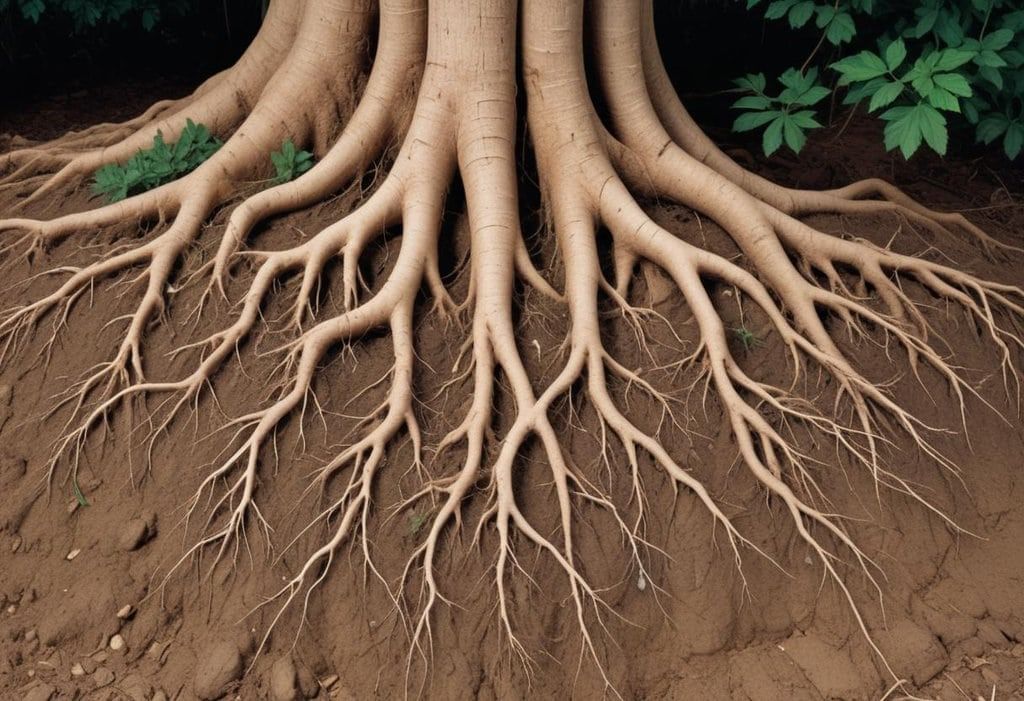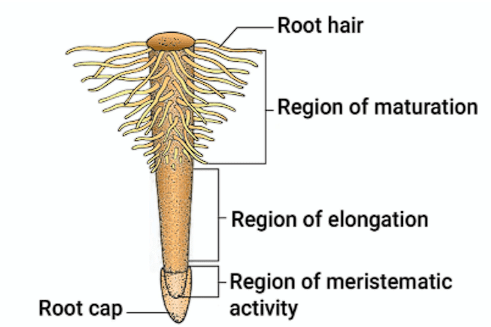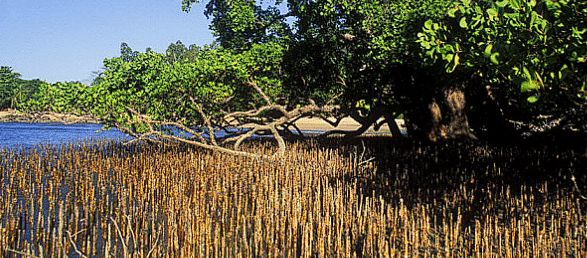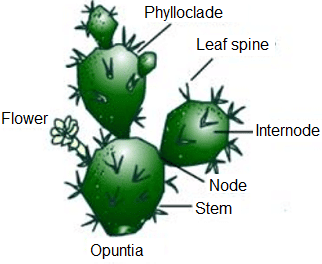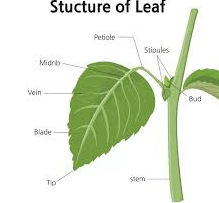|
The taproot system consists of a primary root formed from the elongation of the radicle, which bears secondary and tertiary roots. This system provides stability and access to deeper soil, typically found in dicot plants such as gram and mustard.
|
Card: 2 / 136 |
|
The fibrous root system is characterized by a short-lived primary root that is replaced by numerous roots that emerge from the base of the stem. This system is prevalent in monocotyledonous plants, such as rice and wheat, and helps in anchorage and efficient nutrient absorption.
|
Card: 4 / 136 |
|
Adventitious roots are roots that develop from parts of the plant other than the radicle. They can arise from stems or leaves and are seen in plants like grass, Monstera, and the banyan tree. |
Card: 6 / 136 |
|
The four regions of a root are: 1) Root Cap, which protects the root tip; 2) Region of Meristematic Activity, where active cell division occurs for growth; 3) Region of Elongation, where cells rapidly elongate for primary root growth; and 4) Region of Maturation, where cells differentiate and root hairs form to increase nutrient absorption.
|
Card: 8 / 136 |
|
Root hairs are fine structures that extend from the epidermal cells in the region of maturation. They increase the surface area for absorption, helping the plant to efficiently take up water and minerals from the soil. |
Card: 10 / 136 |
|
What are the different modifications of roots for storage, and can you provide examples? |
Card: 11 / 136 |
|
Roots can be modified for storage in various ways. Taproots, like those of carrots and turnips, store food, while adventitious roots, such as those of sweet potatoes, also serve a storage function.
|
Card: 12 / 136 |
|
What is the role of pneumatophores in certain plants, and where are they typically found? |
Card: 13 / 136 |
|
Pneumatophores are specialized roots that grow upwards above the ground in swampy areas, such as mangroves, to aid in respiration.
|
Card: 14 / 136 |
|
Root nodules in leguminous plants are involved in nitrogen fixation, allowing these plants to convert atmospheric nitrogen into a form that can be utilized for growth. |
Card: 16 / 136 |
|
The main functions of the stem include supporting and spreading branches, conducting water and nutrients, storing food, providing protection, and facilitating vegetative propagation. |
Card: 18 / 136 |
|
A stem consists of nodes, where leaves grow, and internodes, the sections between nodes. It also has buds, which can be terminal or axillary, and is typically green when young before maturing to a woody structure. |
Card: 20 / 136 |
|
A stem develops from the plumule of a germinating seed's embryo, which is the part of the seed that will grow into the shoot. |
Card: 22 / 136 |
|
The modifications of the stem in plants include underground stems like rhizomes, tubers, corms, and bulbs, which help sustain plants during unfavorable conditions; stem tendrils, which support climbing; thorns for protection against grazing; and subaerial weak stems such as offsets, suckers, runners, and stolons for vegetative propagation. Aerial modifications, like phylloclades, adapt the stem for photosynthesis in xerophytic plants.
|
Card: 24 / 136 |
|
Underground stems include rhizomes, which run parallel to the ground and have nodes and buds (e.g., ginger, banana); tubers, where the end part swells (e.g., potato); corms that grow vertically below the ground (e.g., colocasia); and bulbs, which are reduced stems surrounded by scaly leaves (e.g., garlic, onions). These adaptations help plants survive adverse conditions. |
Card: 26 / 136 |
|
Stem tendrils are coiled structures that provide support for tender stems of climbing plants. They aid in climbing by wrapping around supports, allowing the plant to reach sunlight and grow vertically, as seen in plants like grapes, cucumbers, and pumpkins.
|
Card: 28 / 136 |
|
Thorns are modified axillary buds that serve as a protective adaptation for plants, deterring grazing animals from feeding on them. Examples include Bougainvillea and citrus plants, which use thorns as a defense mechanism. |
Card: 30 / 136 |
|
Subaerial weak stems, including offsets, suckers, runners, and stolons, facilitate vegetative propagation. Offsets form rosettes of leaves, suckers arise from underground portions, runners spread horizontally with roots at nodes, and stolons bend to touch the soil, allowing new plants to grow, as seen in species like Eichhornia, banana, and mint.
|
Card: 32 / 136 |
|
A phylloclade is a modified stem that becomes fleshy and green, functioning like a leaf in photosynthesis. This adaptation occurs in xerophytic plants where the actual leaves are reduced to thorns, minimizing water loss through transpiration. Examples include Euphorbia and Opuntia.
|
Card: 34 / 136 |
|
A typical leaf consists of three parts: the leaf base, which attaches to the stem; the lamina, which is the flat part of the leaf; and the petiole, which is the stalk that connects the leaf to the stem. |
Card: 36 / 136 |
|
Stipules are two small leaf-like structures that may be found at the leaf base where it attaches to the stem.
|
Card: 38 / 136 |
|
Venation refers to the arrangement of veins in a leaf, which can vary in patterns such as palmate, parallel, or reticulate venation. |
Card: 40 / 136 |
|
Palmate venation has multiple principal veins spreading out from a central point; parallel venation features veins that run parallel to each other, typically found in monocots; reticulate venation has a network of irregularly distributed veins, characteristic of dicots.
|
Card: 42 / 136 |
|
The main types of leaves are simple leaves, which have a complete lamina without incisions reaching the midrib, and compound leaves, where incisions touch the midrib, dividing the leaf into multiple leaflets. |
Card: 44 / 136 |
|
Examples of leaf modifications include tendrils for support in climbers like peas, spines in xerophytic plants like cacti to reduce water loss, and pitcher plants where leaves trap insects for nutrition. |
Card: 46 / 136 |
|
The apical meristem is responsible for the origin of leaves, as it is the region of active cell division at the shoot tip where new leaves are produced. |
Card: 48 / 136 |
|
The two sub-types of compound leaves are pinnately compound and palmately compound. Pinnately compound leaves have leaflets arranged along a common axis called the rachis, as seen in Neem. In contrast, palmately compound leaves have leaflets that are attached at the tip of the petiole, such as in Silk cotton. |
Card: 50 / 136 |
|
Phyllotaxy refers to the arrangement pattern of leaves on a stem or branch of a plant. It is important as it optimizes light exposure and the efficient use of space for plant growth and development. |
Card: 52 / 136 |
|
The three main types of phyllotaxy are: 1) Alternate phyllotaxy, where a single leaf arises at each node in an alternate manner (e.g., China rose); 2) Opposite phyllotaxy, where a pair of leaves arises at each node, positioned directly opposite each other (e.g., Calotropis); and 3) Whorled phyllotaxy, where more than two leaves arise at a single node in a circular arrangement (e.g., Alstonia).
|
Card: 54 / 136 |
|
Inflorescence is the organization of flowers on the floral axis, where a flower is considered a modified shoot. The shoot apical meristem transforms into a floral meristem, leading to the development of various floral structures at successive nodes instead of leaves. |
Card: 56 / 136 |
|
Racemose inflorescence has a main axis that grows indefinitely, with flowers arranged laterally in acropetal succession (older flowers at the bottom, younger at the top). In contrast, cymose inflorescence has a limited growth main axis that terminates in a flower, with flowers arranged in basipetal order (older flowers at the top, newer ones at the bottom).
|
Card: 58 / 136 |
|
Types of racemose inflorescence include raceme, spike, umbel, capitulum, corymb, catkin, and spadix, each characterized by distinct arrangements and structures of flowers along the main axis. |
Card: 60 / 136 |
|
Cymose inflorescence includes types such as monochasial cyme and dichasial cyme, which are defined by the branching patterns and arrangements of the flowers. |
Card: 62 / 136 |
|
A verticillaster is a type of inflorescence where sessile flowers are arranged in a dichasial cyme. An example of this is found in the plants Ocimum and Salvia. |
Card: 64 / 136 |
|
The cyathium is an inflorescence with an involucre of bracts forming a cup-shaped structure, where a single female flower is surrounded by numerous male flowers. An example of a plant with cyathium inflorescence is Euphorbia. |
Card: 66 / 136 |
|
What is a hypanthodium and which plant exemplifies this type of inflorescence? |
Card: 67 / 136 |
|
A hypanthodium is a special type of inflorescence where both male and female flowers are contained in a cavity with an apical opening called the ostiole. An example of a plant exhibiting hypanthodium is the fig.
|
Card: 68 / 136 |
|
A flower is the reproductive structure in flowering plants (angiosperms) responsible for the production of seeds and consists of a specialized shoot with modified leaves arranged in a specific pattern. |
Card: 70 / 136 |
|
The three types of flower symmetry are: (i) Actinomorphic, which are radially symmetrical flowers; (ii) Zygomorphic, which can be divided into two equal parts in only one vertical plane; and (iii) Asymmetric, which lack any clear pattern of symmetry. |
Card: 72 / 136 |
|
Examples of flowers include: Actinomorphic - Chilli, Datura, and Mustard; Zygomorphic - Cassia and Pea; Asymmetric - typically includes flowers like orchids. |
Card: 74 / 136 |
|
Flowers can be classified as trimerous (3 parts), tetramerous (4 parts), or pentamerous (5 parts), depending on the multiple of floral appendages present. |
Card: 76 / 136 |
|
Bracteate flowers have reduced leaves called bracts present at the base of the pedicel, while ebracteate flowers do not have these bracts. |
Card: 78 / 136 |
|
The three types of flower ovary positions are: (i) Hypogynous, where the gynoecium is at the highest position and the ovary is superior; (ii) Perigynous, where the gynoecium is at the same level as other parts, with a half inferior ovary; and (iii) Epigynous, where the thalamus encloses the ovary completely, making it inferior.
|
Card: 80 / 136 |
|
Examples include: Hypogynous - Brinjal, China rose, and Mustard; Perigynous - Peach, Plum, and Rose; Epigynous - Ray florets of a sunflower, Guava, and Cucumber. |
Card: 82 / 136 |
|
The four main whorls of a flower are calyx, corolla, androecium, and gynoecium. They are attached to the swollen terminal of the pedicel called the thalamus. |
Card: 84 / 136 |
|
The calyx is the outermost whorl of a flower made up of leaf-like structures called sepals. There are two types of calyx: gamosepalous, where sepals are fused into a single structure, and polysepalous, where sepals are free and separate. |
Card: 86 / 136 |
|
The corolla is the whorl of a flower made up of brightly colored petals that follow the sepals. It can be categorized into gamopetalous, where petals are fused, and polypetalous, where petals are free from one another. |
Card: 88 / 136 |
|
Aestivation refers to the arrangement of sepals and petals in a flower. It protects delicate floral parts from adverse environmental conditions such as extreme temperatures, excessive sunlight, or water scarcity. |
Card: 90 / 136 |
|
The main types of aestivation are: valvate, where sepals or petals just touch without overlapping; twisted, where sepals or petals overlap each other in a whorl; imbricate, where margins overlap randomly; and vexillary, where the largest petal overlaps the two lateral petals and two anterior petals.
|
Card: 92 / 136 |
|
The androecium is the male reproductive part of a flower, consisting of stamens, which are made up of a filament and anthers. |
Card: 94 / 136 |
|
The types of androecium include staminode (sterile stamens), epipetalous (stamens attached to petals), polyandrous (free stamens), monadelphous (stamens united in one bundle), diadelphous (stamens united in two bundles), and polyadelphous (stamens united in more than two bundles). Each type varies in the arrangement and connectivity of the stamens. |
Card: 96 / 136 |
|
The gynoecium is the female reproductive part of a flower, consisting of one or more carpels. Each carpel has three main parts: the stigma (receptive surface for pollen), style (connects stigma to ovary), and ovary (contains ovules). The gynoecium plays a crucial role in reproduction by facilitating fertilization and seed development. |
Card: 98 / 136 |
|
Apocarpous gynoecium has multiple carpels that are free from each other, as seen in flowers like roses and lotuses. In contrast, syncarpous gynoecium consists of multiple carpels that are united, such as in tomatoes and mustard. |
Card: 100 / 136 |
|
Placentation refers to the arrangement and positioning of ovules within the ovary of a flowering plant. It is crucial for seed development and fruit formation, as it determines how ovules attach to the ovary via the funicle and placenta. |
Card: 102 / 136 |
|
The types of placentation include marginal placentation (ovules attached along the margin of the ovary, e.g., pea), and axile placentation (ovules attached to a central axis within the ovary, e.g., lemon and china rose). Each type reflects how ovules are organized within the ovary.
|
Card: 104 / 136 |
|
Parietal placentation is a type of ovule attachment where ovules are attached to the inner wall of the ovary, arranged in one or more rows along the inner surface. An example of this is found in plants like Argemone and mustard. |
Card: 106 / 136 |
|
Describe free central placentation and name a plant that exhibits this type. |
Card: 107 / 136 |
|
Free central placentation is characterized by ovules attached to a central column within the ovary, with partitions between the ovules not reaching the center. An example of a plant that exhibits free central placentation is Primrose or Dianthus. |
Card: 108 / 136 |
|
Basal placentation is defined by ovules being attached at the base or bottom of the ovary, with either a single ovule or a group of ovules present. Examples of plants with basal placentation include marigold and sunflower. |
Card: 110 / 136 |
|
A fruit is defined as a mature or ripened ovary developed after fertilization in flowering plants. |
Card: 112 / 136 |
|
Parthenocarpic fruit is a type of fruit formed without fertilization, resulting in seedless fruits. An example of this is pineapple. |
Card: 114 / 136 |
|
The three layers of the fleshy pericarp in a fruit are the epicarp, mesocarp, and endocarp. |
Card: 116 / 136 |
|
After fertilization, the ovule develops into a seed, which is crucial for the propagation and continuation of plant species. |
Card: 118 / 136 |
|
Monocotyledonous seeds, such as maize and wheat, typically have one cotyledon, while dicotyledonous seeds, like pea and gram, have two cotyledons. |
Card: 120 / 136 |
|
The floral formula represents the characteristics of a flower using symbols that indicate the flower's symmetry, sex, number of sepals, petals, stamens, and carpels, as well as cohesion and adhesion within and between whorls. |
Card: 122 / 136 |
|
The vegetative characters of the Solanaceae family include a taproot system, stems that can be erect or climbing, and alternately arranged leaves that are simple or pinnately compound without stipules, featuring a network-like vein pattern. |
Card: 124 / 136 |
|
The main floral characters of the Solanaceae family include complete, bisexual, and regular flowers with five fused sepals (gamosepalous) and five fused petals (gamopetalous). The androecium consists of five epipetalous stamens, while the gynoecium is syncarpous, bicarpellary, bilocular, with a superior ovary and axile placentation. |
Card: 126 / 136 |
|
The types of fruits produced by the Solanaceae family can be a berry or a capsule, containing numerous seeds with endosperm for the developing embryo. |
Card: 128 / 136 |
|
Important food sources from the Solanaceae family include tomatoes, eggplants (brinjal), and potatoes. |
Card: 130 / 136 |
|
Chili peppers are a spice source from the Solanaceae family, commonly used to add heat and flavor to dishes in various cuisines. |
Card: 132 / 136 |
|
Petunias are an example of ornamental plants in the Solanaceae family, valued for their colorful flowers and used in landscaping. |
Card: 134 / 136 |
|
Plants like belladonna and ashwagandha from the Solanaceae family possess medicinal properties, with belladonna used for its anticholinergic effects and ashwagandha known for its adaptogenic benefits. |
Card: 136 / 136 |
 Completed! Keep practicing to master all of them. |







